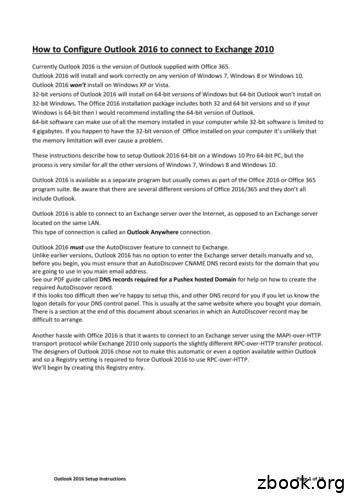2020 Japan Insurance Outlook - EY
2020 JapanInsurance OutlookTrends and imperatives shapingthe life and non-life markets
Compound annual growth rate, grosswritten premium, Japan, 2013–2018In JPYIn ource: Swiss Re SigmaThe Japanese insurance marketis one of the largest in theworld. Life insurance volume isroughly JPY35 trillion, rankedsecond behind the US in totalannual premium. Likewise,the property and casualty(P&C) insurance market isapproximately JPY9 trillion,ranked fourth in the world.022020 Japan Insurance OutlookExpense ratiosLife14.1% 201712.3% 2010Non-life (including commissions ratio)32.6% 201734.6% 2010Source: Life Insurance Association of Japan (LIAJ),General Insurance Association of Japan (GIAJ)
Both life and non-lifeinsurers face significantchallenges in light of anaging population, a lowbirthrate and persistinglow interest rates.Japan’s life insurance premium volume has remainedrelatively flat during the last five years. However, theannual premium from in-force policies seems to haveincreased. The volume decrease in 2016 was due tolower yield caused by Bank of Japan’s policy on lowinterest and product sales suspension.Japanese firms have not been major players in the InsurTechspace to date. Of the roughly JPY242 billion or USD2.24billion invested in InsurTech companies in 2017, only 16%went to Asia, and less than 1% was invested in Japan.Both life and non-life insurers face significant challenges inlight of an aging population, a low birthrate and persistinglow interest rates. Legacy systems and new competitivefactors are also driving change in the market.Projected Japanese age demographics shift, 2008–2038Under 1414%14-6421%Total population11%13%28%127million65%60%55%200820182038 forecast2020 Japan Insurance Outlook115million34%129millionSource: Oxford Economics03Over 64
Key trendsLifeThe unfavorable economic environment, including alingering low interest rate, is among the causes for thedecline in Japan’s life business. It has also been difficultto launch new savings products and other types of offeringsunder such circumstances.Consumers’ needs are shifting away from death protectionand toward life protection (medical, income, etc.). Thus,life insurers are seeking to quickly develop and launchnew products and added-value services to boost revenue.Younger consumers (millennials and Generation Z) aremigrating to new sales channels, such as co-registeredagents, rather than meeting with tied sales representatives.Shift of in-force policies by productThese customers need to be identified and approached withmore enticing products.As technology advances and non-insurance competitors(such as other financial services companies) enter theindustry, it is more important than ever for life insurersto create ecosystems with InsurTechs. Feeling both costand competitive pressures, incumbent life insurers arelooking to the cloud, artificial intelligence (AI), and othertechnologies to replace inefficient legacy systems, enhanceoperational agility, and improve their data and analyticscapabilities and infrastructures.In-force policy %Medical and cancer products grew by 15% from 2000 to2017, reflecting increasing consumer needs for thirdcategory products as well as for caregiving protection.Death protection insurance is not as attractive anymorebecause of the low birthrate and aging population, as wellas the development of advanced medical technologies.The volume of whole life (WL) and term insurance productsincreased relative to the year 2000 due to:14.3%7.3%13.7%13.9%2. More women purchasing WL thanks to increasesin double-income households20.2%3. Sales increase in WL due to reasonable pricingand minimum coverage34.6%042020 Japan Insurance OutlookEndowmentTerm life21.3%1. Sales increase of USD-based WL and low-cashsurrender-value WL policies for the purpose ofsavings and tax advantages4. Switch to simple term products at the time ofrenewing term WLOther35.0%Medical/cancer10.0%2000Source: LIAJ29.7%2018Whole life
Key trends: LifeA life insurance powerhouseFinancial deregulationThe Japanese life insurance market is the third-largest in theworld, following the US and China. Nearly 90% of Japanesehouseholds carry life insurance policies. In contrast, 70% ofUS households and 38% of UK households have life insurance.However, the volume of in-force policies has droppedprecipitously since reaching a peak of JPY1.5 trillion in 1996.One reason for the drop is that the workforce population hit itspeak in 1997 and has been declining ever since.The financial deregulation of 1996 triggered unprecedentedchanges in the Japanese insurance industry. For instance,it introduced:In addition, the unit price of premium per person has beendecreasing due to continuing low interest rates, as well as alow birthrate and increasing longevity. Sales through bankassurance channels and the internetPercentage of Japanese households withlife insurance policies88.7%Decrease of in-force life insurance policyvolume, 1996-2018-43.3%Source: LIMRA, Life Insurance Culture Center, LIAJLife insurance sales by channelTied sales ce: Life Insurance Culture Center052020 Japan Insurance Outlook Liberation of premiums The third category of insurance products(e.g., medical insurance) Co-registered agentsThe “tied sales representative system” allowed a tied salesrepresentative to sell only one company’s products. However,that system was partially eliminated and the “broker system”was adopted. It should also be noted that the JapaneseInsurance Business Act states that only insurers can bestructured as mutual companies. Today, mutual insurers havea market share of around 30%.Shifting channelsTied sales representatives, including life planners, remain aprominent sales channel, especially for life insurance. Butmore customers are buying insurance products at banks orinsurance agencies, including insurance shops, giving thesechannels a stronger presence in the market.The need for system optimizationLife insurance is incredibly prominent in Japan. But theindustry must adopt more aggressive cost-saving programsand increase business efficiency if it is to thrive in the faceof an aging population, low birthrate, and persistent lowinterest rates.Inflexible legacy systems are a significant challenge. The coresystems that support the business still run on mainframecomputers. As a result, insurers have accumulated anenormous number of out-of-date IT assets that are resourceintensive and costly to manage and maintain.
Key trends: LifeImperatives for life insurers123406Focus on highly profitable products with current customers and developnew products, value-adding services, and sales channels suited to diversecustomer needs (e.g., giving advice on health, finance, mental support,ad hoc insurance).Consider how “human plus digital” channels should play in the market anddevelop targeted models and road maps to maximize customers’ lifetime value.Prepare for a future in which insurance products are available on platformslike Amazon by acquiring, partnering with or creating InsurTech players andplatforms to execute key strategies and drive innovation.Embrace AI, the cloud, advanced data analytics, and automation to improvethe efficiency and agility of key value chain functions.2020 Japan Insurance Outlook
Key trendsNon-lifeAutomotive insurance sales, 2018With JPY9 trillion in premium, the Japanese P&C insurancemarket is the fourth-largest in the world, trailing only theUS, China, and Germany. The domestic market is largely anoligopoly. The three largest insurers hold 85.6% of marketshare, while foreign insurers hold only 8%. More non-insurancecompanies (largely financial services players) are entering theP&C market, which could significantly impact the dominantposition of the top P&C insurers.4.3%4.3%91.4%DirectBrokers, etc.AgentSource: GIAJ, FNLIAMarket share of “big three” P&C insurers85.6%Source: GIAJ, Foreign Non-Life Insurance Association of Japan (FNLIA)The increase in damage from severe natural disasters inJapan is leading P&C insurers to redefine risk profilesusing the most up-to-date technologies. Further, they willlook to adopt advanced technologies to reduce the highcost and inefficiency of legacy systems and improve theiroperational agility.Improving commission and operatingexpense ratiosCommission ratios for non-life insurers have dropped by0.4% points from 2002. Company expenses decreased by1.7% points during that same time, showing that operationshave become more efficient.Total expense ratio34.5%34.6%32.5%The dominance of automotiveAutomobile insurance (including compulsory automobileliability insurance) represents 60% of net premium inJapan. A “grading system” determines premiums based onpolicyholders’ accident histories. Agencies dominate sales ofauto policies. Hovering around 4%, direct sales are increasing.Enormous shifts within the automotive market are to beexpected as advanced telematics become more common.17.6%2020 Japan Insurance Outlook17.2%16.9%17.1%15.2%200220102018Source: GIAJ, FNLIA0717.5%CommissionratioAdminexpenseratio
Key trends: Non-lifeImperatives for non-life insurers123408Develop and offer new products and services that address the risks andopportunities relative to new technologies and societal shifts (e.g., thefuture of mobility, connected homes, broader adoption of personal andcompany data transaction).Seize new business opportunities and create ecosystems through mergers andacquisitions and partnerships with InsurTechs and other digital startups.Enhance customer experiences at every touchpoint and strengthen theinfrastructure for existing customers.Leverage technologies like AI, the cloud, and advanced analytics to improve theefficiency of key functions and parts of the value chain.2020 Japan Insurance Outlook
ContactWalter PoetscherEY Japan Insurance Leaderwalter.poetscher@jp.ey.comFor insights into regional trendsand imperatives, please review the2020 Asia-Pacific Insurance Outlook.Read report 092020 Japan Insurance Outlook2020 Asia-PacificInsurance OutlookDriving innovation andtransformation to seizeopportunities and sustain growth
EY Assurance Tax Transactions AdvisoryAbout EYEY is a global leader in assurance, tax, transaction and advisoryservices. The insights and quality services we deliver help build trust andconfidence in the capital markets and in economies the world over. Wedevelop outstanding leaders who team to deliver on our promises to allof our stakeholders. In so doing, we play a critical role in building a betterworking world for our people, for our clients and for our communities.EY refers to the global organization, and may refer to one or more, ofthe member firms of Ernst & Young Global Limited, each of which isa separate legal entity. Ernst & Young Global Limited, a UK companylimited by guarantee, does not provide services to clients. Informationabout how EY collects and uses personal data and a description of therights individuals have under data protection legislation are availablevia ey.com/privacy. For more information about our organization,please visit ey.com. 2019 EYGM Limited.All Rights Reserved.EYG no. 005354-19GblED NoneThis material has been prepared for general informational purposes only and is not intended tobe relied upon as accounting, tax or other professional advice. Please refer to your advisors forspecific advice.ey.com
Source: LIMRA, Life Insurance Culture Center, LIAJ 88.7% Percentage of Japanese households with life insurance policies-43.3% Decrease of in-force life insurance policy volume, 1996-2018 Source: Life Insurance Culture Center Key trends: Life Life insurance sales by channel Tied sales representative Agent 2003 2018 72.0% 7.0% 17.8% 53.7%
Outlook 2013, Outlook 2016, or volume-licensed versions of Outlook 2019 Support for Outlook 2013, 2016, and volume-licensed versions of Outlook 2019 ends in December 2021. To continue using the Outlook integration after the end of 2021, make plans now to upgrade to the latest versions of Outlook and Windows. Outlook on the web
Denki Kagaku Kogyo Japan Denki Kagaku Kogyo Japan Denki Kagaku Kogyo Japan Denso Corporation Japan Denso Corporation Japan Denso Corporation Design engineer Japan Denso Corporation Engineer Japan Denso Corporation Engineer Japan Deutsche Accumotive GmbH & Co. KG Engineer Germany DuPont K.K. Development Supervisor - HEV/EV segment Japan
Beat Mania 1998 2.98 Japan Fighting Games: Street Fighter series 23.00 World-Wide 11.00 Japan Street Fighter II (SNES) 1992 2.88 Japan Tekken series 4.60 Japan Tekken 3 1998 3.36 Outside Japan Tekken 2 1996 2.19 Outside Japan Tekken 1 1995 1.03 Outside Japan Soul Caliber II (PS2) 2003 1.50 Japan Soul Caliber II (GC) 2003 1.00 Japan
o Microsoft Outlook 2000 o Microsoft Outlook 2002 o Microsoft Outlook 2003 o Microsoft Outlook 2007 o Microsoft Outlook 2010 o Microsoft Outlook 2013 o Microsoft Outlook 98 o Microsoft PowerPoint 2000 o Microsoft PowerPoint 2002 – Normal User o Microsoft PowerPoint 2002 – Power User o Microsoft PowerPoint 2002 – Whole Test
Outlook 2003 with Exchange 2010 still gives an excellent email experience and the improvements made in Outlook 2007, Outlook 2010 and Outlook 2013 are relatively minor. Outlook 2003 was the first version of Outlook capable of connecting to an Exchange server over the Internet, as opposed to an Exchange server located on the same LAN.
Outlook Integration with Salesforce Page 1 of 19 Outlook Integration with Salesforce This guide will help you set up the Outlook Integration add-in, which replaces the Salesforce for Outlook app you may be familiar with, within Outlook and Outlook on the Web to connect to Salesforce, and show you how to log emails, events and meetings to Salesforce.
Outlook 2016 Setup Instructions Page 1 of 18 How to Configure Outlook 2016 to connect to Exchange 2010 Currently Outlook 2016 is the version of Outlook supplied with Office 365. Outlook 2016 will install and work correctly on any version of Windows 7, Windows 8 or Windows 10. Outlook 2016 won't install on Windows XP or Vista.
The king's insurance options 5 Things you need to know 7 The stuff you need to do 14 How to claim 16 Our commitment to you 20 Car insurance 22 Car warranty 37 Shortfall cover 45 Scratch and dent 46 Tyre and rim 48 Motorbike insurance 53 Trailer and caravan insurance 64 Watercraft insurance 68 Home contents insurance 77 Buildings insurance 89























